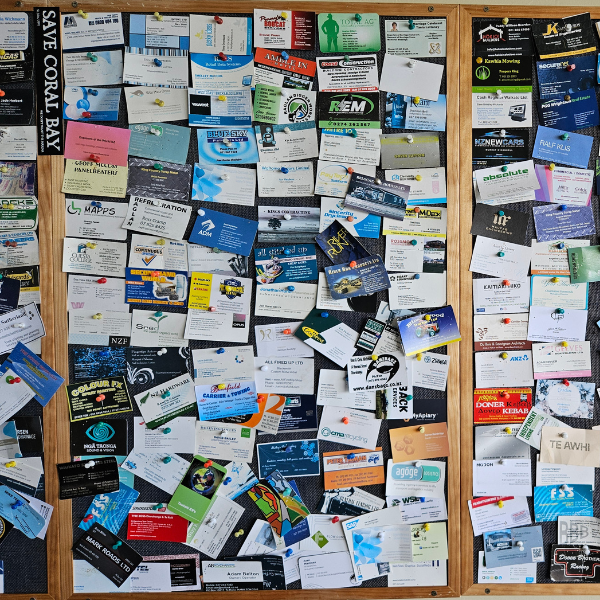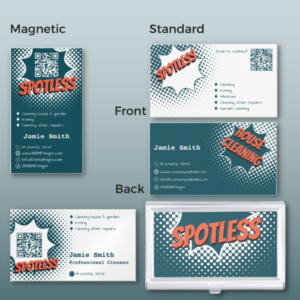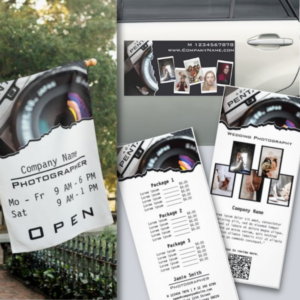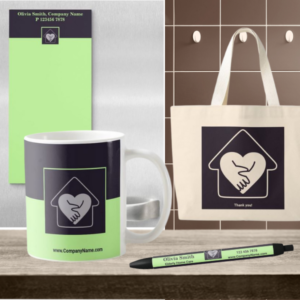Creating an effective offline marketing package for small business involves a combination of elements that help build and promote the brand.
Article content:
- Comprehensive List of Offline Marketing Elements
- A Marketing Package for Small Business, Essential Elements of Branding
- Boost Your Brand: The Power of Small Business Marketing Items
- Discover the Uniqueness of Designs by KBM D3signs on Marketing Materials
- FAQ’s about: Marketing Package for Small Businesses
Here’s a comprehensive list of offline marketing elements and branding strategies:
1. Logo and Visual Identity:
- Develop a professional and memorable logo that reflects the essence of your brand.
- Choose branding colors that support your overall business objective.
- Ensure consistency in color schemes, fonts, and imagery across all materials.
2. Business Cards:
- Create well-designed business cards. Include your logo (photo and/or QR code), contact information, and a short tagline or description of your business. Or even use them as tokens of gratitude in form of a thank you business card.
- For long-term visibility, consider using business card magnets that combine information with utility.
- Use your brand colors red, blue, green, purple, pink, yellow, brown, gray or black and white and let your business card shine.
3. Brochures, Flyers and Rack Cards:
- Design informative brochures ,flyers, rack cards that highlight your products, services or other initiatives.
- Include compelling visuals, key benefits, and a call-to-action.
4. Branded Stationery, Store Wraps & Accessories, Seasonal Greetings
- Use branded letterhead, envelopes, address labels and notepads to maintain a consistent and professional image.
- Where appropriate, use branded gift wrap, note cards, and tags.
- Seasonal greeting cards or customer appreciation cards for valued customers
5. Printed Advertisements:
- Place ads in local newspapers, magazines, or community newsletters to reach a broader audience.
6. Posters and Banners:
- Create eye-catching posters and banners for events, promotions, or to enhance brand visibility.
7. Vehicle Branding:
- Utilize vehicle magnets, decals or wraps to turn company vehicles into mobile advertisements.
8. Signage:
- Invest in well-designed storefront signage to attract foot traffic and reinforce brand identity.
9. Merchandise:
- Produce branded merchandise such as T-shirts, pens, or mugs to give away at events or as promotional items.
10. Direct Mail Marketing:
- Send targeted postcards or letters to a specific audience with special promotions or offers.
11. Event Sponsorship:
- Sponsor local events, fundraiser or community activities to increase brand exposure.
12. Promotional Materials:
- Distribute branded promotional materials like keychains, fridge magnets, calendar magnets, planners, notebooks or stickers at trade shows, workshops or community events.
13. In-Person Networking:
- Attend local networking events and trade shows to personally connect with potential customers and partners.
14. Storefront Displays:
- Create visually appealing displays in your storefront window to attract passersby.
15. Uniforms and Apparel:
- Have employees wear branded uniforms or apparel or name tags to create a consistent and professional appearance.
16. Customer Testimonials:
- Display positive customer testimonials in your physical location to build trust and credibility.
- Support the word-of-mouth process with a referral card or gift certificates and vouchers or discount cards.
17. Educational Workshops or Classes:
- Host workshops or classes related to your industry to position your business as an expert.
18. Loyalty Programs:
- Implement a loyalty program with physical loyalty cards or stamps to encourage repeat business.
19. Community Engagement:
- Engage with the local community through sponsorships, partnerships, or charitable activities.
20. Press Releases:
- Write and distribute press releases about significant milestones, events, or new offerings.
Remember to evaluate the effectiveness of each element and adjust your offline marketing strategy based on the results. Consistency in branding and a focus on building meaningful connections with your audience will contribute to the success of your small business.
A Marketing Package for Small Business, Essential Elements of Branding
Effective branding is critical for small businesses to stand out, build trust, and leave a lasting impression on customers. A well-defined brand not only helps attract and retain customers, but also sets the stage for long-term success. Here we explore the essential elements of branding for small businesses, offering insights and practical tips to help entrepreneurs build a strong and memorable brand.
1. Define Your Brand Identity
The first step in creating a powerful brand is to define your brand identity. This includes your mission, values, and unique selling proposition (USP). Consider what sets your business apart from competitors and how you want your customers to perceive you. Your brand identity should be reflected in every aspect of your business, from your logo and visuals to your messaging and customer interactions.
2. Create a Memorable Logo and Visuals
A visually appealing and memorable logo is a cornerstone of effective branding. Your logo should be simple, versatile, and representative of your brand identity. Consistent visuals, including color schemes and design elements, across all platforms help reinforce brand recognition. Invest in professional graphic design to ensure a polished and cohesive visual identity for your small business marketing package.
3. Craft a Compelling Brand Story
Storytelling is a powerful tool in branding. Share your journey, values, and the passion behind your business. A compelling brand story helps create an emotional connection with your audience, making your brand more relatable and memorable. Use your story consistently across marketing materials, your website, and social media platforms.
4. Consistent Branding Across Platforms
Maintain consistency in your branding across all customer touch-points. Whether it’s your website, social media profiles, or physical storefront and employee appearance, a cohesive brand presence builds trust and reinforces your identity. Consistency in messaging, visuals, and customer experience helps create a unified brand perception.
5. Understand Your Target Audience
Knowing your target audience is fundamental to effective branding. Understand their needs, preferences, and pain points. Tailor your brand messaging and communication style to resonate with your audience. This not only attracts the right customers but also fosters a sense of community around your brand.
6. Build a Strong Online Presence
In today’s digital age, a strong online presence is essential for small businesses. Develop a user-friendly and visually appealing website, optimize it for search engines, and maintain active and engaging social media profiles. Your online presence is often the first interaction customers have with your brand, so make it count.
7. Deliver Consistent Quality
Your brand is not just about visuals and messaging; it’s also about the quality of your products or services. Consistently delivering high-quality offerings builds trust and reinforces a positive brand image. Customer satisfaction plays a crucial role in shaping perceptions and fostering loyalty.
Ultimately, effective branding is a strategic asset that can set your company apart from the competition. By defining a strong brand identity, creating memorable visuals, telling a compelling story, maintaining consistency, understanding your audience, building a robust online presence, and delivering consistent quality, you can create a brand that resonates with customers and lays the foundation for long-term success. Remember, successful branding is an ongoing process that evolves with your business and your customers.
Discover the Uniqueness of Designs by KBM D3signs on Marketing Materials
Our commitment to our mission is reflected in our exceptional marketing materials designed by KBM D3signs. We strive to simplify the customization process by offering easily customizable templates within our marketing packages. Our belief is rooted in the idea that everyone should have the freedom to choose their preferred colors for a selected design, ensuring that it perfectly matches your vision and needs.
At the Cocoon It! Store by KBM D3signs on Zazzle puts all the branding elements and color schemes in your hands. Whether you’re choosing products with a QR code – where the second color is limited to black or white for optimal contrast – or exploring the vast array of customizable elements through the “Edit further” link, your brand’s unique identity is yours to define.
We use color tools to help you choose the perfect hues, and for additional inspiration, explore our curated collection of color palette ideas. Our commitment to customization goes beyond placeholders-almost all elements can be customized to match your chosen colors.
If you need additional assistance customizing or transferring designs to different products, or if you have a unique vision that requires a custom design, we are just a message away. At Designs by KBM D3signs, we go beyond providing marketing materials; we empower you to shape and showcase your brand with creativity and personalization.
Shop at Zazzle Store
Cocoon It! – Business Cards & Marketing Items
Boost Your Brand: The Power of Small Business Marketing Items
Admittedly, establishing a strong brand presence is essential for success. While digital marketing plays a crucial role in reaching a wider audience, the impact of tangible, physical marketing items should not be underestimated. Small business marketing products serve as tangible representations of your brand, creating lasting impressions and fostering customer loyalty. In this article, we’ll explore the importance of small business marketing collateral and highlight some effective strategies for making it work for your brand.
The Tangible Connection:
In an era dominated by digital interactions, the value of physical touch-points cannot be overstated. Small business marketing items provide a tangible connection between your brand and your customers. Whether it’s a branded pen, a custom notepad, a stylish tote bag, or branded apparel these items create a lasting impression by putting your brand directly into the hands of your audience.
Brand Visibility and Recognition:
Consistent brand visibility is a key component of successful marketing. Small business marketing items act as miniature billboards, keeping your brand at the forefront of customers’ minds. Branded merchandise, such as T-shirts, hats, or water bottles, turn your customers into walking advertisements, increasing brand recognition as they go about their daily lives.
Cost-Effective Marketing:
For small businesses with limited marketing budgets, investing in promotional items is a cost-effective strategy. These items often have a lower cost per impression compared to traditional advertising methods. Additionally, they offer a higher perceived value to customers, making them more likely to engage with your brand.
Build Customer Loyalty:
Small business marketing items can be powerful tools for building customer loyalty. When customers receive a thoughtful and useful promotional item, they feel appreciated and valued. This positive experience fosters a connection between the customer and the brand, increasing the likelihood of repeat business and word-of-mouth referrals.
Choose Items with a Purpose:
When selecting marketing items for your small business, consider the practicality and usefulness of the item. Items that align with your brand and provide value to the recipient are more likely to be retained and used. For example, if your business is eco-friendly, consider reusable bags or sustainable water bottles as promotional items.
Integrate with Your Marketing Strategy:
To maximize the impact of small business marketing items, integrate them seamlessly into your overall marketing strategy. Use them as incentives for online and offline campaigns, giveaways at events, or as part of a customer loyalty program. By aligning these items with your broader marketing efforts, you create a cohesive and memorable brand experience.
Quality Matters:
Investing in high-quality marketing items reflects positively on your brand. Cheap and poorly made items may convey a negative impression and undermine the perceived value of your products or services. Choose items that reflect the quality and professionalism of your brand to leave a lasting and positive impression.
Overall, every opportunity to stand out and make a lasting impression is critical in the competitive small business landscape. Small business marketing products offer a tangible and cost-effective way to increase brand awareness, build customer loyalty and create a memorable connection with your audience. By strategically incorporating these items into your marketing efforts, you can differentiate your brand and leave a lasting impression on your customers.
-

6 Offline Summer Marketing Ideas for Small Businesses
Read the post …: 6 Offline Summer Marketing Ideas for Small Businesses -

What is Seasonal Marketing? A Guide for Small Business Offline Success
Read the post …: What is Seasonal Marketing? A Guide for Small Business Offline Success -

Mother’s Day Marketing Ideas for Small Local Businesses
Read the post …: Mother’s Day Marketing Ideas for Small Local Businesses
FAQ’s about: Marketing Package for Small Businesses
Building a strong brand offline is crucial for small businesses as it establishes credibility, fosters trust with the local community, and differentiates the business in a competitive market.
An effective offline marketing package includes branding essentials (business cards, brochures), print advertising, direct mail campaigns, event participation, networking efforts, in-store promotions, vehicle branding, and local sponsorships.
Understand your customer demographics, preferences, and behavior. Analyze existing customer data, conduct surveys, and engage with the local community to tailor your message to the right audience.
Personalized content increases engagement by making recipients feel valued. Utilize variable data printing to include personalized elements such as the recipient’s name and tailored content based on their preferences.
Incentives and specials motivate action. Including exclusive offers or discounts creates a sense of urgency, encouraging recipients to take immediate steps, such as making a purchase or visiting your business.
Small businesses can use direct mail campaigns by creating targeted, high-quality mailing lists, crafting compelling content, and offering incentives. Personalization and a clear call-to-action are essential for success.
Implement tracking mechanisms such as unique codes, phone numbers, or dedicated landing pages. Regularly analyze response rates and customer feedback to measure the impact of your offline marketing package.
Absolutely. Integrating offline and online strategies creates a comprehensive marketing approach. Consistent branding across both channels enhances visibility and engagement, reaching a broader audience.
Attend local events, join business associations, and explore partnerships. Networking builds relationships within the community, leading to word-of-mouth referrals and increased credibility for your small business.
Ensure compliance with regulations, including data protection laws and postal regulations. Work with reputable printing and mailing services, and regularly update your mailing lists to maintain accuracy.
-

What Is A Brand Partnership? – A Small Business Perspective
Read the post …: What Is A Brand Partnership? – A Small Business Perspective -
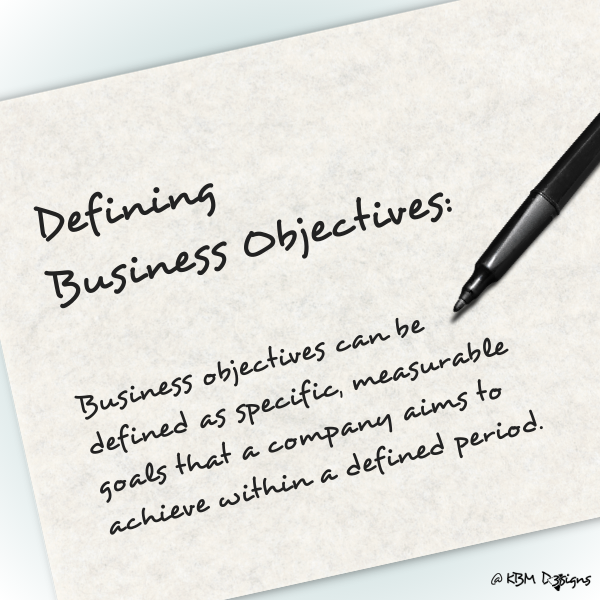
What Are Business Objectives?” Perspective Of A Small Business
Read the post …: What Are Business Objectives?” Perspective Of A Small Business -

What Is A Focus Group Market Research? – SMB Perspective
Read the post …: What Is A Focus Group Market Research? – SMB Perspective


